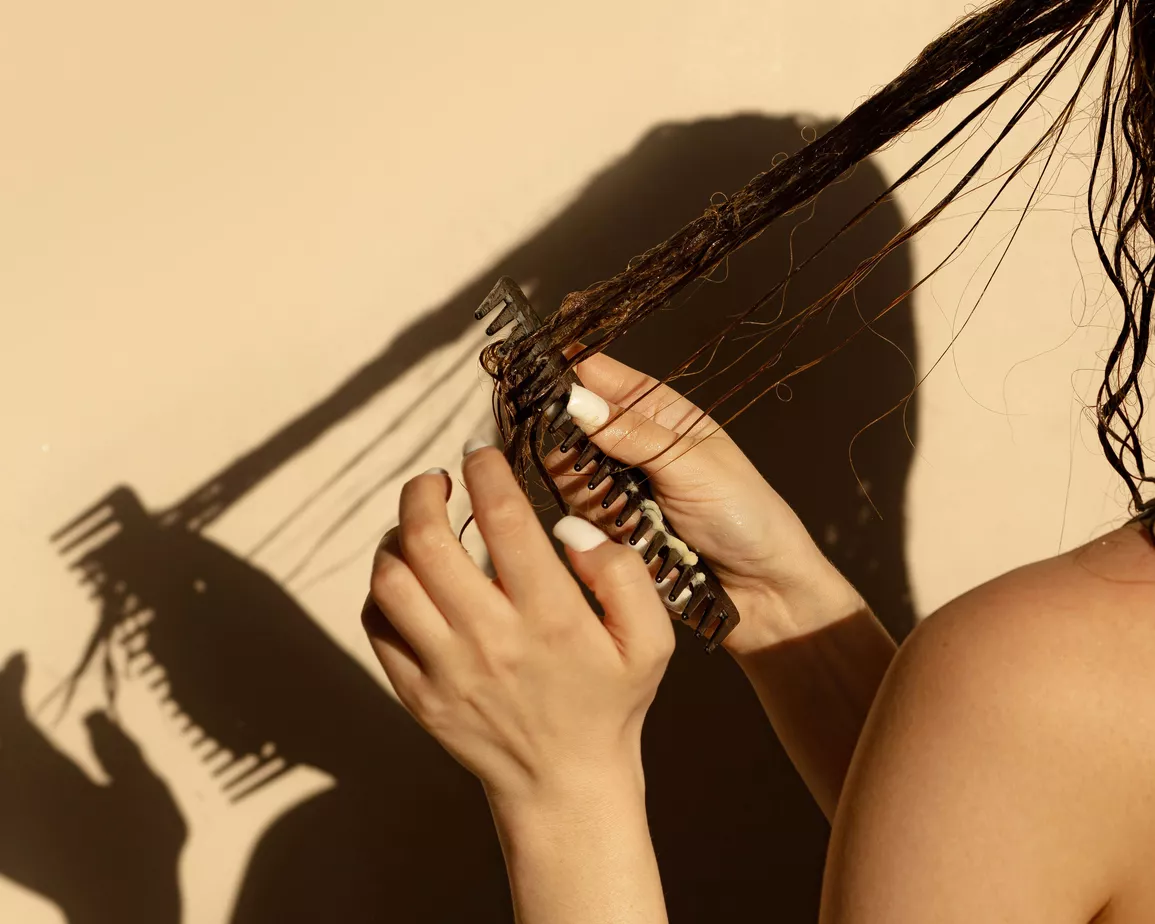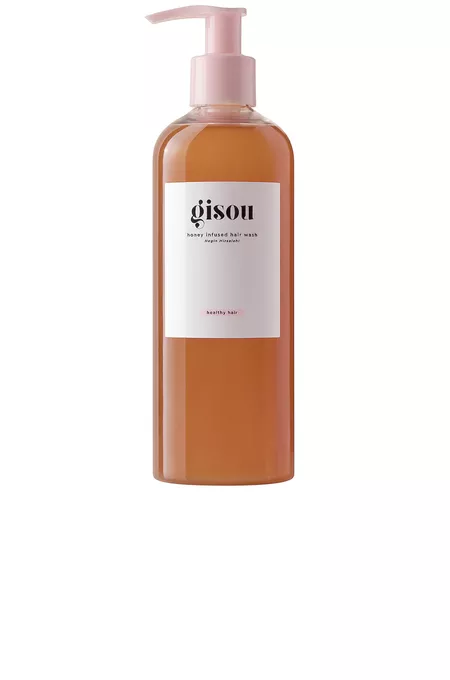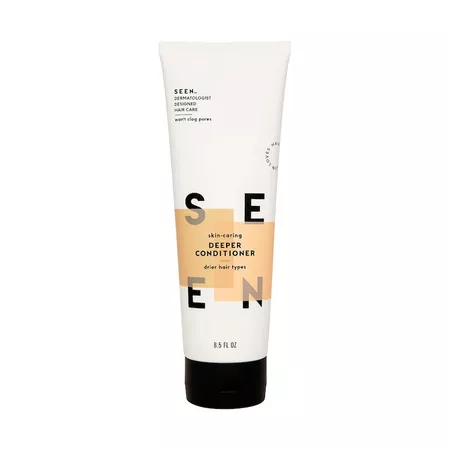
Asya Molochkova / Stocksy
The snag of a brush colliding with a tangle is painful on multiple levels—physically, of course, but also emotionally, as you can often hear the breakage it causes. Anyone with hair long enough to brush knows that tangles are an unavoidable consequence of lengthy locks. But while some degree of tangling is to be expected, there may be some behaviors or products that contribute to the frequency and severity of your tangles.
Tangles are typically made up of a combination of "live" hair still attached to your scalp and "dead" hair that has already been shed from your scalp. The approach to tackling tangles is multi-faceted, as you need to remove the shedded hair without causing further damage to the live hair. There are steps you can take to avoid creating tangles, as well as best practices for detangling them once they have formed.
In order to understand the full story behind what contributes to tangles, we turned to two hair experts: trichologist Karen Flowers and dermatologist Iris Rubin, MD.Keep reading for their advice on the best way to prevent and tackle tangles.
Meet the Expert
Iris Rubin, MD, is a board-certified dermatologist and the co-founder of SEEN Haircare.
of 08
Use a Sulfate-Free Shampoo

Honey Infused Hair Wash Shampoo
$37.00
Shop
One of the factors that impact tangling is hair dryness. "Tangling is more common in dry and damaged hair because the cuticles don’t lie flat, which allows strands to snag against each other and become intertwined," says Rubin. One way to reduce dryness is to use a sulfate-free shampoo, as these cleansers remove dirt without stripping the hair of its natural oils. Using a sulfate-free shampoo can minimize the drying of the hair that can happen with sulfate-based surfactants, explains Rubin.
of 08
Detangle With a Wide-Tooth Comb While Conditioning
Preventing tangles starts in the shower, according to Rubin. One of the best practices you can implement to both prevent and treat tangles is to use a wide-tooth comb during your conditioning treatment. "Before rinsing conditioner, use a wide-tooth comb to gently work out any knots," she says. "This helps release tangles without any extra pulling or tugging on the hair."
By combing with the conditioner in, you are increasing the hairs elasticity with the moisture of both the water and product. Increased elasticity minimizes breakage and damage to the hair. This can be especially helpful for those with dry, damaged, or even fine hair that may already have reduced elasticity.1
of 08
Use a Microfiber Towel
Avoiding friction is the name of the game when it comes to preventing tangles. Traditional towels are some of the worst perpetrators of friction, but any towel can become problematic if used too vigorously. Rubin recommends seeking out a microfiber towel to dry hair gently. "To prevent tangles caused by friction, use a microfiber hair towel to gently blot excess water out of the hair," she says. She cautions that even with a microfiber towel, its important to avoid roughly rubbing your hair while drying.
The RëzoTowel ($22) is an ultra-soft microfiber towel turban that makes gently drying hair easy and luxurious. Rëzo Hair Care is designed for curly hair, so it makes sense they use microfiber for their towel, as Rubin explains that naturally curly hair is also more prone to tangling because the strands don’t lie flat, in turn increasing the chances that they will wrap around each other.
of 08
Try a Pre-Shampoo Treatment
If you know that you have tangles before washing your hair, Flowers recommends doing a pre-shampoo oil treatment and finger detangling before entering the shower. "Our hair strands are impacted throughout the day by our hands, styling utensils, hats, coats, pillows, sweating, or even the wind," she says. "When our curls intertwine for long periods of time or are dry, this can lead to tangling. A gentle detangle is always best before hair washing, to minimize further tightening of tangled strands." She recommends saturating the hair with coconut oil the night before wash day, as it takes about eight hours for coconut oil to fully penetrate the hair shaft. "Coconut oil softens hair, making it more pliable and easier to remove tangles. The oil also strengthens the hair to minimize breakage during this process."
This can be especially helpful for those with curly and textured hair, as Flowers explains that our hair sheds every day, but with curly and kinky-curly textured hair, most of the shed hair stays in the hair shaft until wash day. "I recommend that hair be first finger-detangled to remove most of the shed hair prior to saturating the hair with water," she says. "This is really important if you’ve been wearing a protective style for weeks because you can expect a significant amount of shed hair after the style is taken down. This shedding is normal as it has built up over time."
of 08
Protect Your Hair During Sleep
While avoiding friction may seem easy enough, we often forget that the largest culprit for friction is sleep. Both Rubin and Flowers mention friction caused by movement while sleeping can lead to tangling. Rubin shares that keeping hair pulled back while exercising and sleeping can help prevent tangling; she likes silk scrunchies for these activities because they don’t damage the hair.
Silk pillowcases are a popular choice for minimizing sleep friction, and they have proven results. If youre not ready to make the (sometimes significant) investment in a silk pillowcase or are looking for a silk sleep alternative for travel, check out the Silk Hair Wrap ($50) from Damn Gina. This silk-lined turban lets you tuck your strands safely inside to protect them from the material of your pillow.
of 08
Get Regular Trims
If youre looking to grow out your hair, you may be hesitant to get frequent trims as it seems counterproductive. But your split ends could cause damage and breakage that ultimately hinders growth. Split ends are annoying, but they can also contribute to tangling. Flowers explains that its important to get trims regularly, at least two to three times a year or as needed to remove split ends. "Split ends cause both shed and neighboring hair strands to attach to the ends (which are weakened) and create tangles. Getting your ends trimmed regularly will help alleviate this issue," she says.
of 08
Avoid Products That Cause Buildup on Hair

Deeper Conditioner
$28.00
Shop
Buildup can cause all sorts of problems for the hair, but it can also cause tangles. You have likely tried products that made your hair feel sticky or tacky and its obvious to see where those contribute to tangling. One less obvious perpetrator is silicones, as these tend to build up slowly on the hair and actually make it feel smoother to the touch. But over time, this buildup can create tangle-causing friction in the hair as well.
Rubin recommends using a conditioner that will not contribute to buildup on the hair. "A high-quality conditioner is a must, and if you comb your hair before rinsing and gently blot the hair dry this will help reduce tangles significantly," she says. "SEEN’s conditioners contain an ingredient called hemisqualane, which is a natural alternative to silicone that’s derived from plant sugar. It smoothes the hair cuticles to help prevent tangles, and makes for easier combing and brushing."
of 08
Deep Condition Regularly
Hydration is essential to keeping hair elastic and less likely to break, as dry hair is more prone to friction and tangling. As such, regular deep conditioning treatments can improve both the health and appearance of your hair. Flowers recommend super hydrating conditioners that will help give the hair “slip” when detangling. "One such example is the Curl Houses Follicle Stimulating Growth Conditioner ($28), which contains botanicals, humectants, and oils that maximize moisture and provide excellent slip for both conditioning and detangling," she says.
Kavitha S, Natarajan K, Thilagavathi G, Srinivas C. Effect of oil application, age, diet, and pigmentation on the tensile strength and breaking point of hair. Int J Trichology. 2016;8(4):155-159.